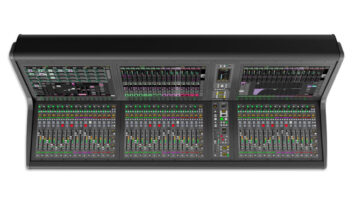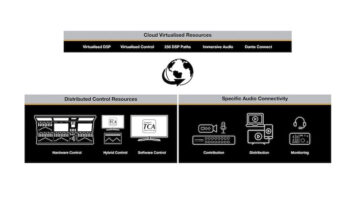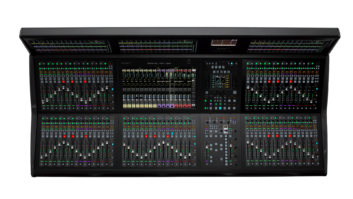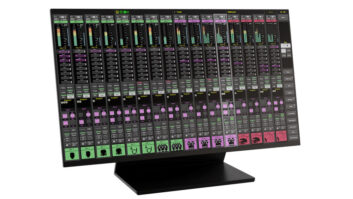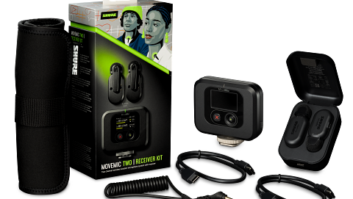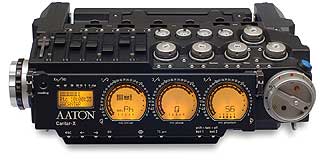
During the past few years, the industry has been flooded with portable “pocket” 2-track digital recorders. But in an increasingly complex world of location recording, two channels are sometimes not enough. Even on a relatively simple job—such as miking two characters for a film/video—the recordist may need to print two radio mics, a hidden set mic, a boom and a couple ambience mics for flavor/walla. Or, unpredictable levels may dictate the need to run several mics at different levels (with/without pad) or placements—even for a mostly mono source. When recording a volcanic eruption, space-shuttle launch or car crash, there’s just no chance to run it one more time to get the levels right.
If you’re seeking a fully portable recording solution—i.e., 100 percent DC-powered—options abound. While outside the scope of this article, there are also laptop-based solutions such as MOTU’s Traveler MkIII or Metric Halo’s Mobile I/O interfaces paired with recording software, such as Gallery Software’s Metacorder or other pro DAWs. Such a rig will certainly do the job, but it’s hard to imagine running down the street to follow fast-moving action with a laptop tethered to an interface.
This article takes a look at current offerings in location recorders, focusing on single-box, multichannel systems. Recorders are lighter, more reliable, better-sounding and more affordable than ever, making this a good time for some shopping.
Aaton Cantar X2 has a built-in 18-input mixer.
The Aaton Cantar X2 ($13,995) provides 8-track capture to the removable, hot-pluggable internal hard disk or to the onboard DVD drive at 24-bit/96kHz resolution. The unit also has a built-in 18-input mixer and onboard M/S decoding, with nine rotary analog faders and six linear mixer sliders. The swiveling front panel makes for optimal viewing; in addition to its eight analog XLR inputs and two XLR outs, AES/EBU digital, timecode, word clock and FireWire are standard. The latter allows simultaneous recording to both the internal and external drives, while the analog complement includes five preamps and four line inputs. The 18 inputs (XLR mic/line and eight AES/EBU) can route to any tracks or outputs. Weight is 7.5 pounds, less battery.
Systems can be expanded with CantaRem (a compact 8-channel fader control surface) and GrandArcan, a Mac/PC application that remotely controls Cantar, displaying all recording, routing and monitoring parameters, plus metadata associated with each audio file. Cantar automatically generates a print-ready “PDF Sound Report” log that’s archived with the audio files. Circled takes, slate locators, track info, etc., can be entered from Cantar’s control panel, an external keyboard or a wireless (Bluetooth) connected PDA. Metadata is embedded in the AES31 description field that is readable by most nonlinear video editors.

Edirol’s R44 4-channel deck
Edirol offers two 4-channel recorders. Its flagship R-4 Pro ($2,295) can slave to or act as a master to any device via SMPTE LTC timecode. Other features include AES/EBU I/O (XLR), 4-channel analog I/O (XLR combo), USB 2 backup, individual monitoring of its four channels and uncompressed recording up to 96kHz/24-bit. Supported sample rates include 44.1/48/88.2/96/192 kHz, and the R-4 Pro can also record 24-bit/192kHz in stereo mode. The R-4 Pro also provides onboard waveform editing capacity via the LCD and jog/scrub/shuttle wheel, as well as cue-point marking during record or playback and an A/B repeat function for quickly comparing any of the audio on any two points for reviewing takes, etc. The R-4 Pro’s internal 80GB hard drive can store approximately 116 hours at 16-bit/44.1kHz in WAV or BWF formats. The four analog inputs include phantom-powered mic preamps with individual gain controls. Weight is 3.75 pounds.
Priced at $995, the Edirol R-44 4-channel deck stores to SD or SDHC card media. Like the R-4 Pro, it offers up to four channels of uncompressed audio at 16/24 bits from 44.1 to 96 kHz (and 192 kHz in stereo mode only). WAV or Broadcast WAV is supported, and two R-44s can sync for up to 8-channel recording. It has XLR and 1/4-inch TRS inputs. The XLR inputs have phantom power and a limiter. The high-speed USB 2 port allows for copy and archive to PC or Mac. Digital I/O is S/PDIF coaxial. Weight is 2 pounds, 14 ounces.
Features common to both the R-4 Pro and R-44 include RCA analog outputs, onboard parametric EQ, graphic EQ, noise gating, compressor/de-esser and enhancer effects usable during recording or playback. Also standard are built-in omnidirectional mics and a pre-record function that captures audio before the Record button is pushed. Powering is via an external AC adapter, eight AA cells or a 4-pin XLR DC jack.
The PD606 ($9,995) from Fostex offers eight tracks of recording with two virtual tracks storing to full-sized DVD-RAM discs, plus dual-drive recording, support for 6+2 poly files, and a digital mixer and router with a stereo bus. Up to 8-track/24-bit recording is supported through its AES/EBU inputs, or six tracks (plus a stereo mix track) at 96 kHz through the six analog inputs. Full 176.4/192kHz is supported for 2-track recording. Tracks are stored to BWF, and an Avid-compatible EDL file (ALE) can be created and edited. The PD606 records to the internal (user-replaceable) 1.8-inch 80GB hard disk and DVD-RAM discs. Simultaneous recording to both media is available either by mirroring or auto-copy. A Background mode automatically copies recorded audio from the hard disk to DVD when the machine is idling. The DVD drive can also write to DVD-R/RW and CD-R/RW discs for data copy/backup. The PD606 mounts directly to a host PC via USB, and a standard QWERTY keyboard can connect for file name editing.
Sync functions include a 9-pin ES-Bus remote port to lock a second PD606 for simultaneous recording, along with video/tri-level/word sync and SMPTE generator. Also standard is 0.1-percent Fs pull-up/down for video lock. Powering is via two IDX Endura batteries or external 12 VDC. Weight is 12.5 pounds.
Nagra’s VI ($8,200) is a 6-channel (four mic/two line) recorder that stores audio with 24-bit/96kHz resolution to an internal 120GB HD or Compact Flash media. The onboard mixer can take the four mic inputs to a stereo mix on channels 5/6, or five analog inputs to a mono mix on channel 6. The mic inputs have phantom power and limiters, along with a built-in matrix and two M/S mic decoders. Analog inputs 5/6 can switch to accept AES-3 digital signals. Audio is stored as Broadcast WAV. USB connectors provide access for external devices and the Nagra VI appears as a drive on a PC or Mac. A 5-pin Lemo port handles timecode in/out at standard SMPTE/EBU formats, as well as the 23.976 fps for HD production, and any frame rate or sample rate (44.1/48/88.2/96 kHz) can pull up/down 0.1 percent for the NTSC markets. The sunlight-readable, 320×200-pixel, 3.5-inch TFT display shows operating status, bar graph modulometers, take numbers, timecode and more. Power is via a lithium-ion battery or the 4-pin XLR DC connector. Two 12 VDC sockets power external devices such as wireless receivers. Weight is 8.3 pounds.

Sound Devices’ 744T 4-track model
Sound Devices’ top-end 788T deck—the “T” suffix stands for timecode—records 12 tracks (eight mic/line inputs and four additional tracks for stereo mixes or aux feeds) to an internal 160GB drive, Compact Flash media or an external FireWire HD or DVD-RAM (with bus powering). A 788T-SSD version exchanges the conventional HD for a 256GB solid-state hard drive. Any or all of these can be used simultaneously, and audio is stored at up to 24-bit/96kHz as Broadcast WAV, mono or poly files, or uncompressed PCM. The eight analog inputs offer peak limiters for mic inputs, as well as adjustable highpass filters. Support for AES-42 digital mics is also available, with eight channels of AES-3 digital input and six channels of balanced AES-3 output. The 788T can be clocked from external word clock or from video sync, and a timecode reader/generator is standard. Auto-record features allow chasing external rec-run video sources. To simplify metadata entry (or for keyboard shortcut control), the 788T accepts USB keyboards. Powering is via lithium-ion batteries or a 10 to 18VDC jack. Weight is 2.6 pounds without battery.
The 788T retails at $5,995. Options include the CL-8 mixing control surface with eight rotary faders and pushbuttons for setting highpass filter, limiter, polarity, mutes and routing. New for 2010 is the CL-9 Linear Fader Controller ($2,250), a dedicated mix surface featuring eight ultralow-latency linear faders and rotary input trim controls, while adding pan controls and single-band parametric EQs for each input.
The 744T ($4,395), the 4-track cousin of the 788T, shares many—though not all—of its features, including onboard timecode sync. It features two mic preamps (with phantom, limiters and highpass filters); channels 3 and 4 are line-level inputs on TA3 connectors; and four AES-3 digital I/Os are standard. Uncompressed PCM audio tracks (MP3 is also supported) at up to 24-bit/192kHz store to an 160GB internal drive, CF card or external FireWire, with simple connection to Mac or PC for transfer or data backup. Weight is 2.6 pounds.

Tascam HS-P82 8-track with timecode
Tascam’s HS-P82 ($6,999) 8-track field recorder with timecode has eight XLR mic/line inputs—with limiter, HP filtering and individual phantom power—storing up to 96kHz/24-bit audio (or four channels at 192kHz) Broadcast WAV files to dual Compact Flash media for backup, mirroring and seamless A/B recording. A USB port offers high-speed data transfer to PC or Mac systems. The HS-82P can also record a stereo mix for 10-channel capture. Analog outs are balanced XLR. A DB-25 port handles eight AES/EBU I/Os, with a stereo AES feed on a BNC. The unit features metering and status on a TFT color touch screen; up to five seconds of pre-record buffering; video or word clock sync; a PS/2 keyboard input for track naming; onboard slate mic; timecode I/O; and a variety of power possibilities, such as 10 AA batteries, NP-type, AC adapter, external DC port and an optional V-mount adapter for Endura batteries. Weight is 8 pounds, less batteries.
The new Tascam DR-680 ($1,399) can simultaneously record six analog tracks—four XLR and two TRS mic/line with phantom power—plus two digital (S/PDIF) inputs. Alternatively, the unit’s onboard mixer can route a stereo mix to two channels while storing the six discrete mic inputs. The DR-680 writes WAV files onto SD/SDHC media at up to 96 kHz or can create 2-channel 192kHz/24-bit recordings. It can also create multichannel MP3 audio. A cascade cable can connect two DR-680s for up to 16-track recording. The DR-680 also provides a pre-recording feature, six unbalanced RCA analog outputs, S/PDIF I/O, USB port for connection to PC or Mac, and it includes basic field edit functions such as divide and delete. A 128×64 backlit LCD handles metering, time/location and status displays. Power is via eight AA batteries, external 12VDC port or an included AC adapter. Weight is 2.65 pounds.
Zaxcom’s flagship Deva 16 ($14,995) offers 16-track recording at up to 24-bit/192kHz to internal HD, internal DVD-RAM drive, CF card and external FireWire devices. Standard are 12 analog inputs (eight mic/line and four balanced line with phantom power), eight digital inputs, eight digital direct outs, a built-in 16-channel/24-bus mixer with eight hardware faders and EQ, notch filter, compressor and delay on each channel. A color touchscreen shows time, location, metering and status, and allows for metadata entry or a PS2-compatible keyboard to be connected. A Pre-Record mode stores up to 10 seconds of audio before the Record button is pressed. Files are created as broadcast WAV, mono or poly or in ZAX format, with Avid and Pro Tools compatibility; timecode is handled in sub-frame accuracy. Headphone monitoring is flexible, offering an onboard M/S matrix, with user and factory presets (including a Soundfield decoder). Power is via an internal NP-1 battery or external 12 to 18VDC source. Weight is 7.4 pounds without battery.
The Deva 5.8 ($12,995) offers a feature set similar to that of the Deva 16, but is a 10-track package with eight faders (expandable with the optional Deva Mix-12 control surface) and offers up to 192kHz recording simultaneously to HD, CF and DVD-RAM. Standard are eight analog mic/line inputs, eight digital I/Os and 16-channel mixing. Weight is also 7.4 pounds.

Zaxcom’s flagship Deva 16
Zaxcom’s Fusion 12 ($8,500) is a combo 16-channel mixer/12-track recorder with a color touchscreen interface providing instant control to 300 mixer crosspoints and some 200 user parameters. Inputs are eight mic/line-switchable preamps with limiters and four AES digital input pairs with SRC. The 16 mix inputs can route to eight output buses, recording 12 tracks at up to 192 kHz to dual Compact Flash slots and external FireWire devices using Mobile Audio Recording Format (MARF), BWF and FAT32 formats. All timecode rate/formats are supported. A Camera/Stereo RF Link function via the Hirose 10-pin port on many cameras offers a 2-channel camera feed with audio return to Fusion and (with Zaxcom’s TRX900AA transmitter) also sends timecode. Weight is five pounds, less the NP-1 battery.
The Fusion 10 ($7,995) system puts the same quality of the 12 in a more affordable package, and pairs the 16-channel mixer with a 10-track recorder, with similar I/O (eight analog mic/line preamps, eight digital channels) storing to CF slots. Weight is also five pounds. Now included with both Fusion 12 and 10 systems, the Zaxcom Effects Package uses Fusion’s 32-bit DSP to provide 3-band (peak/shelving) EQ, notch filters, soft-knee compressor, expander and delay on every channel.

Zoom R16 recorder/interface/controller
Available to all Zaxcom systems is Zax-Net, a 2.4GHz RF network for distribution of remote-control signals, timecode, IFB audio and metadata for production sound.
The R16 ($699) recorder/interface/controller from Zoom has 16-track playback and 8-track simultaneous recording using SDHC memory (up to 32 GB). Converters offer 24-bit/48kHz WAV recording via built-in stereo condenser mics or eight XLR mic inputs. Also standard is a hi-Z input, Mackie Control emulation and 100 built-in effects. The R16 runs on battery or USB power, comes with Steinberg Cubase LE, and when doubling as a DAW controller/front end, supports Windows XP/Vista and Mac operating systems.
George Petersen used to record location tracks on a beat-up Uher deck and was amazed when crystal sync became the norm in the mid-’70s.


